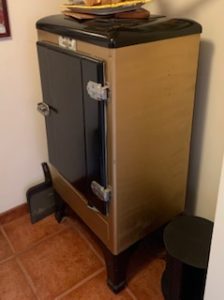 In the 1930s, the early years of refrigeration, the refrigerator market boomed. Inventors became busy with new ideas for many types of units for the home. A whole slew of refrigerator repair men sprang up overnight and whole rooms received a redesign.
In the 1930s, the early years of refrigeration, the refrigerator market boomed. Inventors became busy with new ideas for many types of units for the home. A whole slew of refrigerator repair men sprang up overnight and whole rooms received a redesign.
My favorite huge refrigerator room is in the Pabst Mansion in Milwaukee, a custom kitchen with a walk-in refrigerator like a huge bank safe, connected to the important mechanical parts in the basement. The great hulk of a unit was built into the 1892 Flemish Renaissance Revival beast of a house in a semi-dilapidated area. My mother and I visited, marveled over the amount of beer stored in that ice-box.
1930s Refrigerator for the Home
PW sent me, by comparison, a small unit, as units for the home came in the 1930s, and quite expensive for the average buyer, costing over $300 at that time. But you got great service, as the Frigidaire man came and gave you lessons. PW’s comes from the late 1930s, a model called the R114 Frigidaire by GM.
What moving parts so furiously developed for the new technologies made people spend this kind of money in the 1930s? Well, they offered different inventions for the operative parts of the unit, such as:
- the top mounted drop in unit
- all types of compressors, either belt driven or rotary,
- a single or twin cylinder type compressor
- capillary copper tubing
People considered PW’s fridge very popular as it boasted the Meter Miser, a rotary compressor designed for a whole new type of coolant. Freon-114 worked well with a low wattage compressor, and it saved you money.
Competition and Danger
The competitors in the market were those strange looking units with a head on top, a Monitor Top, which held the compressor. Truth be told, these proved the better machines, because of their quietness and they lasted for 30 years. These used a different type of coolant or refrigerant, called methyl formate. These monitor top units lost market share to the cleaner lines of the bottom–run units like PW’s. But they cooled more area for less, and some had double doors and freezer units, even back then.
As Thomas Edison said a few decades ago: “hell, there are no rules here, we’re just trying to accomplish something!” Because the market became so diverse, refrigerator man was a good job in those days, but you needed to be a mechanic, a vacuum expert, and a chemist. And you needed bravery, because the refrigerants became deadly in many cases. A common coolant, sulfur dioxide, when exposed to the air coated everything with a gum like film, and killed people, plants, and pets. The coolant needed draining in some cases, so the remedy became as deadly as the coolant. They discharged the gas into a bucket of water and lye.
Any Interested Buyers?
PW asked if I saw any value to such a unit, which worked up to a few years ago. The problem is the refrigerant needed to run a test on such a unit will cost $225 for a small canister of R114 Freon. Compare this to the value of the unit today which hovers around $400. And then, as you read, so much more can break down, and there are no more Frigidaire men around to do house calls. Or are there???
As I researched this article, I noticed hundreds of blogs devoted to old refrigerators, directed to pickers and collectors, as well as garage-based mechanics. One photo shows a proud man surrounded by 50 old refrigerators in a garage with his wife looking on disapprovingly. I found peripheral businesses such as one in Chicago that buys old refrigerant of many toxicities. You will know what you have by the color of the cylinder. So hazardous is the stuff that special courses teach how to handle the refrigerants, because they damage the Ozone layer, and YOU.
The good news, PW? If you post it online, you will no doubt find an eager mechanical person. They will haul it away and torture their partner with the acquisition of yet another huge unit to put into the garage and take apart, at great bodily threat. And that person will spend time and money on it, powder-coat it, and love it.